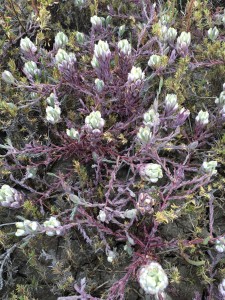Researching an Endangered Plant: Salt Marsh Bird’s Beak
Have you ever seen Salt Marsh Bird’s Beak? You might be thinking of a bird who may have an interesting beak, but what if I told you Salt Marsh Bird’s Beak is actually a plant? This plant grows in small clumps that have green stems with purple ends and cream colored flowers with yellow or purple tips on top.
 As an endangered species, Bird’s Beak population has been monitored on the Sweetwater Marsh for years. In fact, this study is the longest running case study of a human-planted Bird’s Beak population in the world! A few years ago there were attempts to sow seeds throughout The Sweetwater Marsh in order to increase population. However, these attempts were deemed unsuccessful as the plant needs very specific conditions to thrive. This left the population at around 100 plants as of two years ago, when the last survey was conducted. Recently, Living Coast Horticulturist Mark Valen was part of a Salt Marsh Bird’s Beak survey done here at the Sweetwater Marsh Unit of the San Diego Bay National Wildlife Refuge. However Mark was not alone as other scientists from across the country flew in to count Bird’s Beak as well. To everyone’s surprise, Bird’s Beak seemed to be everywhere! They counted over 14,000 individual Bird’s Beak plants on the marsh. We certainly hope this means the tides are turning and this plant population is receiving the specific conditions it needs to thrive.
As an endangered species, Bird’s Beak population has been monitored on the Sweetwater Marsh for years. In fact, this study is the longest running case study of a human-planted Bird’s Beak population in the world! A few years ago there were attempts to sow seeds throughout The Sweetwater Marsh in order to increase population. However, these attempts were deemed unsuccessful as the plant needs very specific conditions to thrive. This left the population at around 100 plants as of two years ago, when the last survey was conducted. Recently, Living Coast Horticulturist Mark Valen was part of a Salt Marsh Bird’s Beak survey done here at the Sweetwater Marsh Unit of the San Diego Bay National Wildlife Refuge. However Mark was not alone as other scientists from across the country flew in to count Bird’s Beak as well. To everyone’s surprise, Bird’s Beak seemed to be everywhere! They counted over 14,000 individual Bird’s Beak plants on the marsh. We certainly hope this means the tides are turning and this plant population is receiving the specific conditions it needs to thrive.
So the next time you’re out on our trails, keep an eye out for the Salt Marsh Bird’s Beak and know you might be seeing the comeback of a truly spectacular species!
